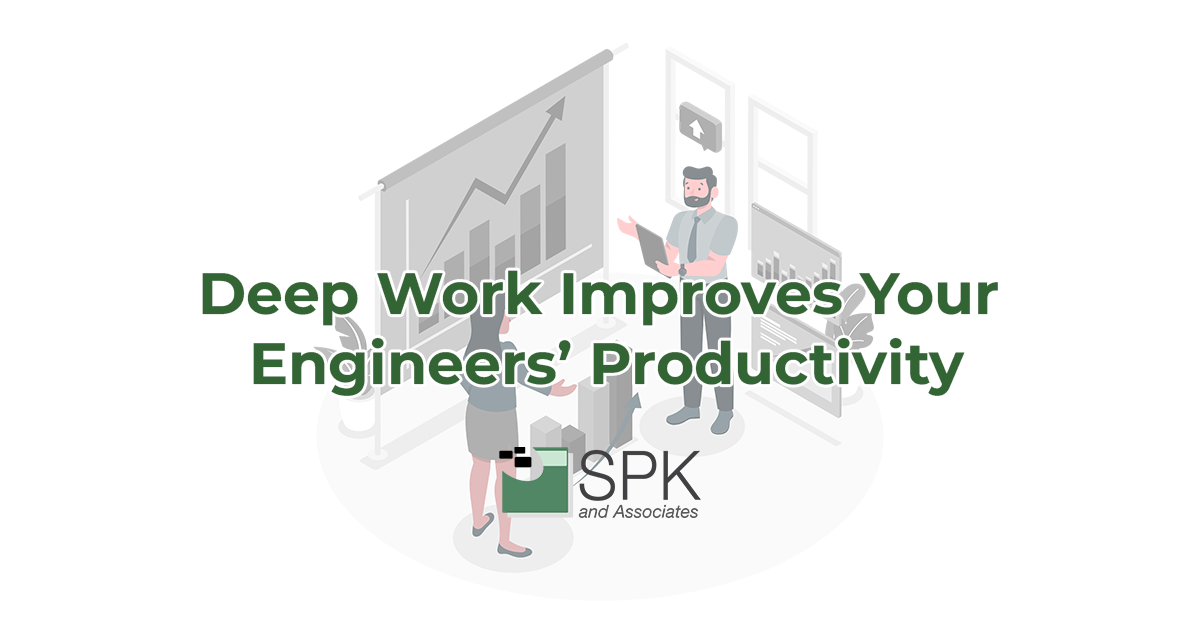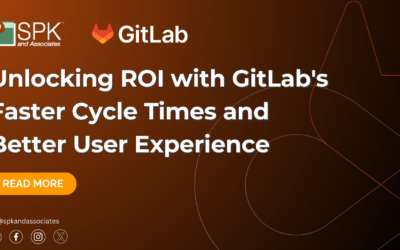In this blog we’ll explore how the principle of Deep Work by Cal Newport can improve your engineers productivity.
Does it feel harder for you to focus on your creative, technical work?
When I speak to engineers or management staff and ask this question, the answer usually comes back as a resounding “yes.” I’ve had conversations with colleagues where they sheepishly respond that they feel they’ve completely lost their ability to concentrate on creative or difficult tasks.
What’s happening?
Rituals For Creative Thinking.
Years ago, I worked for a wonderful manager (let’s call him David) who was responsible for writing proposals to obtain funding for economic development projects. The proposals were involved; the writing required focus and was often difficult. He was an excellent and productive writer, and successfully raised a lot of money.
He preferred to write with pencil and paper (an idea that deserves its own article some time!). On the days when he was going to write, he told me that he would come into the office, get himself a good cup of coffee. He wouldn’t talk with anyone, but would immediately enter his office and shut the door.
Then, he would retrieve all the pencils out of his desk, and proceed to sharpen each one to perfection. Every last pencil. He’d lay them all out on the table, along with the paper, then immediately start to write. He always did it the same way.
I was extremely curious about this ritual. What did it accomplish? Why do this?
We’ll look at those questions shortly. But first, let’s look at the current state of today’s workplace.
A World Without Email
Recently, I read Cal Newport’s latest book, A World Without Email. He states that “there was a time when tools like email felt cutting edge, but a thorough review of current evidence reveals that the “hyperactive hive mind” workflow they helped create has become a productivity disaster, reducing profitability and perhaps even slowing overall economic growth. Equally worrisome, it makes us miserable.”
I can identify with that.
However, I would say that compared to general business staff, most engineers work in an improved environment. Work management tools like Atlassian Jira have been in place for a while. Software engineering was the first team in companies that established better practices, using tools like Jira to organize and collaborate more efficiently. They broke somewhat out of the hyperactive hive mind and the frenetic multi-tasking and attention switching that goes with it.
Other engineering teams have followed suit. They are moving away from unstructured, message-driven, reactive work modalities, to structured, Kanban-organized task management.
But clearly, we haven’t done enough. Otherwise, the answer to the question I asked at the beginning of this article – does it feel harder to focus on creative, technical work – would be different.
While there are many areas to work on, in order to tame the hyperactive hive mind, there are a few in particular that are more prominent.
The Email and Messaging Trap
Newport’s book covers this problem in detail, while providing scientific background as to why human beings are not suited to the incessant back-and-forth of electronic messaging.
We all know and feel that email (and other messaging services like Slack, Teams) is a time-sucking, black hole, into which it’s possible to waste our best energies. However, it can be tamed. Newport explores various possible solutions.
The meaningful solutions require a significant philosophical shift in an organization, and hard work to implement it. If an engineering team’s work is coordinated by ad-hoc, interruptive, back and forth messaging, or messaging is the key vehicle for collaboration, true creative and productive work will be missing.
The engineers need to work within a framework, or set of processes. This allows them to step away from email or Slack, etc. without concern they are derailing a project due to their lack of response. If that framework is not in place, stepping away from email simply delays the team’s progress and creates stress for the engineer stepping away. All of us have experienced the sensation of being absent from the email inbox, and we all know the stress of unanswered messages piling up, increasing our future email debt.
Taming The Beast
At our company, we’ve introduced a number of strategies to tame this beast. And, we keep experimenting. For example:
- Actively using email group addresses composed of multiple engineers on the team, so that questions or problems are received by more than one person.
- Creating a “triage” role for our support desk. This role moves from engineer to engineer, for 4 hour periods . It ensures that one person is monitoring the email queues and responding, but frees the other engineers from babysitting email.
- Assigning a Primary engineer and cross training a Secondary engineer for every client and technology area, so that more than one person is familiar with the issues.
- Rigorously using our work management tools, Atlassian Jira and Confluence, to create, manage, assign, and monitor tasks and projects. We manage both individual and team efforts in Jira, NOT in email or Slack. Each day starts with a standup meeting for each team. We confirm priorities, answer questions, and remove any existing bottlenecks.
- Setting internal and external expectations for communication response – these “communication SLA’s” are different for voice, text, Slack, and email.
- Unless the question is simple with a simple answer, have a conversation – if you really need an answer right away, pick up the phone or walk over to the person. Don’t engage in back-and-forth messaging conversations.
Leverage Engineering Work Management Tools
Managing work in email or Slack, instead of something like Jira, creates a domino effect of problems. It feels efficient, like no time is wasted, and responses are immediate. Yet, problem areas become very apparent:
- You can’t prioritize well in email: The last message that you see becomes the thing you work on, and it’s rarely the most important.
- It forces you into multitasking, and rapid context switching: As you jump from message to message, you also jump from project to project, or client to client, or task to task. This rapid context switching creates serious mental fatigue, and prevents any real focused or deep work. (See Deep Work by Cal Newport)
- The sight of a long list of emails in your inbox creates stress: You feel compelled to respond quickly, and not keep your colleagues waiting. As you’re answering, more are coming in. You cannot escape.
There are more, but just these three are enough.
With a work management tool, benefits are immediate, even without more sophisticated processes:
- Projects and tasks can be organized by priority, by due date, and grouped appropriately. It is clear what should be worked on, not just the last message that grabbed your attention.
- The entire team has visibility to the tasks, not just you, so tasks can be more easily shared and workloads balanced.
- Kanban boards (or something similar) can be introduced. Kanban boards using something like “backlog”, “in progress”, and “done” columns are a fantastic psychological tool for humans. When we only look at the handful of tasks we are going to work on that day (in progress), it frees us up to really focus on them. Subsequently it produces deeper, creative work and removes stress.
It is also extremely helpful for engineers to block time on their calendar for “focus,” or deep work. These are blocks of time where all messaging, phone calls, distractions are turned off, and the discipline of consecrated work takes place. Of course, you have to solve the email/messaging trap first, before focus time is even an option.
The Trap of “Admin” Work – Tool Support
Engineers are one of the few teams in a company that have the technical knowledge to support their own technology tool stack. However, managing their own technology is a distraction trap. They fall into this role because it feels easier. Or, they unconsciously start working on these tasks because it might be easier than their hard, creative work.
Either way, it’s a waste of time for design and development engineers.
There is no doubt that engineers rely heavily on their tech tools, and the tools need to be functioning flawlessly for engineers to create and ship good work. A better answer is to engage a technology support team that specializes in engineering apps and systems. Let them manage the tech. That way the product development engineers can focus on their creative work, and not get distracted.
Lessons Learned From David
But what about David the manager, and his pre-writing rituals? They can apply to any creative, focused work, including engineers. They apply even more so today, in our complex work world. How can we best produce great, creative, focused work?
1. “… get himself a good cup of coffee…” First, treat yourself to something you enjoy. It definitely helps.
2. “… wouldn’t talk with anyone, but would go into his office immediately and shut the door…” Don’t check email or messages; don’t start reading the news; don’t wander down the office hall (if you’re in one) and chat. Close the door on every distraction. Literally close the door.
3. “…retrieve all the pencils out of his desk, and proceed to sharpen each one to perfection…” Every person has to find their own pencil sharpening ritual. It should be a simple task, not susceptible to distraction; something you do each time, signaling to yourself that the hard, deep work comes next; the last thing you do before jumping in. I clean off my desk completely, including wiping it down. I know someone who cleans their screen and keyboard.
4. “He’d lay them all out on the table, along with the paper, then immediately start to write.” Then you start, immediately. Even if you’re not in the zone yet, you start, in order to move into it.
Conclusion
Engineering work is creative, and requires deep focus. In an internet connected world of incessant interruption and noise, focused work is hard to accomplish. But we can take individual and organizational steps to set up our work lives in a way that supports and promotes creative, focused work
By creating frameworks that allow your engineers to remove the need to respond to emails and other communications for a set period of time, you can improve productivity.
Introducing processes such as triage engineers can ensure mailboxes are monitored whilst your other engineers complete more in-depth work like Deep ork. Engineering work management tools like Atlassian Jira can vastly improve smooth collaboration and reduce the shallow work or distractions for your engineering teams.
Identifying rituals that signal to yourself that deep work is ready to commence can help you get in the zone for creative thinking and problem solving.
Want to improve your engineering team’s productivity? Contact us now to discuss further.






